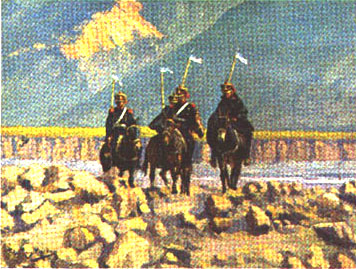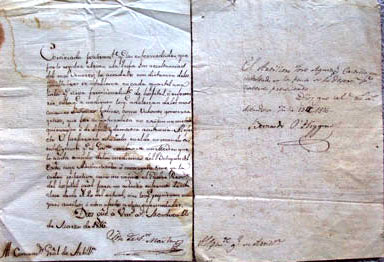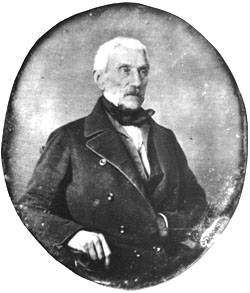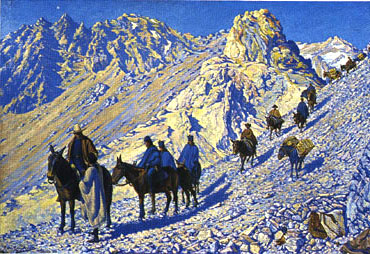| Abstract
General
José de San Martín began his career in the Spanish Army
and suffered diverse injuries and illnesses both there
as well as in the South American campaigns. We prepared
a chronological order of his multiple illnesses - some
of doubtful origin - trying to understand how a sick man
could have crossed the Andes to fight battles in Chile
and to finally triumph over the Spaniards with the surrender
of their army in Peru. The illnesses of this Spanish American
general and the health and hygiene of his army were decisive
to the destiny of almost half a continent.
The
Illnesses of General José de San Martín
José
Francisco de San Martín (1778-1850), the Liberator of
the southern countries of South America, was born in Yapeyú,
in the Spanish Viceroyalty of the Río de la Plata, on
25 February 1778. He travelled to Spain, and at the age
of twelve was admitted into the Regiment of Murcia. He
fought in the Battles of Melilla, Orán, Arjonilla, Bailén,
and Albuera. His ship was seized by the English and it
was probably there that he learnt of the liberation movements
inspired by Masonic groups. Back in the regiment of Cádiz,
San Martín joined Los caballeros racionales de Lautaro
lodge and had contacts with the Semanario Patriótico
newspaper.
The
manuscripts in the Baldrich family collection covering
the Spanish American campaign and our research on José
de San Martín’s health led to a review of his bibliography,
so as to establish a chronology of his illnesses in a
period when these could determine the course of wars.
1801:
Wound in thorax and hand. As a soldier in Spain, he was
injured while carrying objects of value (3,300 reales)
on horseback from Valladolid to Salamanca.
1803:
Sabre wound on the left arm in the Battle of Albuera.
1808:
Gout, hyperuricaemia (high levels of uric acid in the
blood) and arthritis. According to our records he suffered
episodes in 1817, 1818, 1841. For his arthritis he would
take baths in the Tunuyán River and at the hot springs
of Cauquenes in Chile, a treatment recommended by Dr Colisberry.
There were also signs of arthrophaty (arthritis) in the
right arm and fingers; in the daguerreotype published
by The Mosquito newspaper there were signs of
advanced arthropathy in the fingers of his right hand.
1808:
Asthma. The first signs were recorded in 1808. In 1814
he suffered another crisis in Mendoza and was attended
by a Peruvian doctor, Juan Isidro Zapata. According to
Olazábal, when San Martín arrived at the Portillo pass
in the Andes in 1823, he complained of feeling exhausted.
1809:
Haemoptisis (coughing up blood). Most historians discarded
this and maintained that they were the symptoms of haematemesis
(bleeding from the mouth).
1813:
Luxation of the shoulder, face wound and crushing of the
leg, when he returned to the Río de la Plata in 1812,
and trained a cavalry regiment (Granaderos a Caballo).
His first battle against the Spaniards was when he concealed
his soldiers behind the San Lorenzo Monastery, where the
Spanish usually stayed to rest, and he was able to take
them in a surprise attack. The strategy was successful,
but San Martín's horse suffered a fall which injured his
leg. Doctor Francisco Cosme Argerich attended him.
1814:
Haematemesis. According to Martín de Pueyrredon, the army’s
diet was based on coffee, chilli, charqui (dehydrated
salted meat), onion, and the traditional alcoholic beverage
known as aguardiente. (2)
This symptom could have indicated a chronic duodenal ulcer.
The pain was episodic. He was treated with opium and developed
an addiction to this drug. There is evidence that he used
it in 1816, 1821, 1832, 1833, 1834, 1840, 1841, 1844,
and 1847. Gailatoire put forward another diagnosis, tuberculosis,
but this was discarded as there was neither fever, nor
weight loss, nor any expectoration.
1816:
Angina, according to the edict drawn up by Governor Toribio
de Luzuriaga.
1817:
Essential tremor. There are multiple sources which confirm
that San Martín wrote with difficulty and that he needed
the help of a secretary or scribe. The soldier Zenteno
recorded the military orders that were later signed by
San Martín. San Martin suffered from arthropathy of his
right wrist, which could have been gout and essential
tremor. It is not clear if San Martin actually wrote or
was assisted by Zenteno to write out the orders. In a
letter from J. M. de Pueyrredón to San Martín the former
says that 'the day before yesterday I received your last
letter written by a scribe due to the weakness of your
pulse.' From a comparative analysis of both documents
signed by San Martín, it is obvious that the text belonged
to the same handwriting as that of a secretary named Zenteno,
although later they were signed by San Martín himself.
There is a letter from Manuel Belgrano to San Martín recommending
'galvanism', a treatment using a galvanic machine. He
described the new treatment as electricity generated by
a dynamo and applied to the trembling region on the body.
1819:
Haemorrhoids and anal fistula. This information was obtained
from a letter to Tomás Guido.
1820:
Dysentery. During the Chilean campaign there was an epidemic
of dysentery which caused the death of San Martín's friend
Antonio Alvarez Jonte, member of the government of the
Río de la Plata in 1812.
1821:
Malaria (also known then as the 'Valley of Huaura's disease',
misnamed 'Yellow Fever' although San Martín and his soldiers
were in contact with the 'Aedes Aegypti' mosquito.
It started suddenly after the onset of dysentery. There
were 1,500 independent cases, and amongst the Spanish
soldiers 3,000 fell ill. This epidemic and the famine
of the Spanish royal army became a strategic reason for
their surrender, making it easier to conquer Lima, the
main city of the Viceroyalty of Peru. Differential diagnosis:
salmonellosis. Furthermore, during San Martín’s return
from Peru, and whilst he was living at Bernardo O'Higgins’s
house near Santiago de Chile he suffered a bout of exanthemata
typhus. This is caused by fleas from rats, but there are
no other references to identify this cause and no mention
of the pathognomonic rash. It could have also been Chavalongo,
a regional folkloric name (from chavo: sleepy
and louco: head) for an unknown chronic disease,
characterised by prolonged fever and a bowel-colonic process.
Differential diagnosis: typhoid fever.
1826:
Erysipelas. 'Since the last time I wrote to you I have
been suffering from illness and anguish: whilst I was
on my way to a friend's country home the carriage tipped
over and I dislocated my right arm developing an erysipelas
from which I have not yet fully recovered' (San Martín
to Manuel de Estrada).
1832:
Cholera. San Martín had enemies in Buenos Aires, so he
had to abandon the United Provinces of the Río de la Plata
and was exiled in Europe during an epidemic of cholera
there (1831 to 1837). He and his daughter showed signs
and symptoms of this disease, and were helped by Mariano
Balcarce (son of General Balcarce) who came over from
London. Differential diagnosis: a cholera frusta form
(a choleric gastroenteropathic infection from Salmonella
typhus.)
1833:
Epilepsy: referred to in a statement by Manuel Ricardo
Trelles, which states that San Martín suffered a seizure
in the presence of Posadas whilst they were travelling
from Paris to Rome to purchase a sculpture of Napoleon.
It was also mentioned in a letter from San Martín to Bernardo
O’Higgins. There were other seizures during 1836 and 1848.
1840:
Influenza.
1845:
Cataracts: Dr Sichel was the ophthalmologist who performed
surgery on San Martín in 1849 in Paris, without anaesthesia.
There was no improvement.
1850:
Death. Causes unknown (may have been ulcer complications,
cancer, heart failure or aneurism).
Health
and Hygiene in the Army of the Andes
During the South American Wars of Independence José de
San Martín faced serious sanitary and health problems
in his Army of the Andes. Manuscripts shed light on the
diseases suffered by the troops during the different campaigns,
and the hygienic and medical measures implemented by San
Martín’s doctors, amongst them Juan Green and Patricio
O’Donnell. Bernardo O’Higgins also played an important
role in these historical events and in the prevention
of illnesses.
|
 Granaderos a Caballo al galote by Fidel Roig Matons
Granaderos a Caballo al galote by Fidel Roig Matons
|
In
1816 San Martín was in Mendoza, a city in the Cuyo region
of the United Provinces of the Río de la Plata, organising
an army for the independence campaign. The discovery of
a document about the dermatological venereal diseases
of the troops that was signed by San Martín in 1816 led
to an exploration of the historical context and the circumstances
of that period. The document, the existence of which was
known, has not as yet been completely researched and/or
interpreted:
Having
positively confirmed that the diseases generally affecting
the troops are the result of venereal ailments, following
the doctor’s advice I have decided to set up a consulting
room in every quarter which will be used provisionally
as a hospital or nursery, in which those suffering from
the most common galic symptoms, such as ‘vubones;, gonorrhoea
and others that for their nature do not require surgery,
neither do they require difficult nor prolonged assistance.
In order to do so, you will prepare this consulting
room under your mandate with the knowledge that the
government will appoint a doctor to assist you using
the drugs available at the army’s apothecary for which
the administrator or person in charge has already received
the appropriate orders, as has the President Priest
of the General Hospital not to admit patients with these
types of diseases as from the 20th of this month, unless
they require major assistance or are affected by other
diseases. May God protect you for many years. Mendoza,
March 12th, 1816 (José de San Martín to Pedro Regalado
de la Plaza). (3)
This
document proves that consulting rooms were created in
regimental quarters which served as anti-venereal hospitals,
and that Dr Pedro Regalado de la Plaza, General Commander
of Artillery had been appointed to assist San Martín.
It also confirms the existence of dispensaries and apothecaries
and proves the existence of the Director and President
Fray Pablo de Rosario at the general and military Bethlemitic
Hospital of San Antonio in Mendoza. The patients were
admitted to the hospitals depending on the complexity
of the treatment.
Another
document confirms that Fray Luis Beltrán, a priest, was
appointed Lieutenant General of Artillery and Chaplain
of the Army. Finally, a third document in the collection
signed by Bernardo O’Higgins is not related to health
and sanitation, but important to the historical context.
The
historic context regarding these documents: Diseases and
Hygiene
During the colonial period of the Viceroyalty of the Río
de la Plata, the science and art of healing was regulated
by the Protomedicato. After 1810 it was replaced by the
Medical Military Institute, which regulated the education
of doctors during this transitional period.
When
José de San Martín replaced Manuel Belgrano in the Northern
Army at Tucumán, he requested doctors from Buenos Aires:
Cosme Argerich, Guillermo Colisberry from Philadelphia,
and English-born Diego Paroissien. General Belgrano, leader
of the Northern Army, had his own doctor, Joseph Thomas
Readhead. When the Spanish Royalist soldiers were in need
of a doctor in Salta, Readhead was kidnapped but was able
to escape and rejoined the Northern Army.
José
de San Martín, Governor of the Cuyo region, was charged
with the organisation of military health and hygiene for
the civilian population as well as for the troops. He
established military hospitals in the cities of Mendoza
and San Juan, the general and military Hospital of Mendoza
and the Bethlemitic Hospital of San Antonio, which was
located near the Zanjón canal (in the intersection of
present-day San Luis and Francisco de la Reta streets
of San Juan). There was another hospital in San Juan,
the Bethlemitic Hospital San Juan de Dios. The Bethlehem
priests, who supported independence, acted as nurses and
doctors. Not only did they cater for the hospitals but
also offered their help on special missions and in military
matters. After Fray Pablo del Rosario, Fray Juan Pedro
de Santa María became Director of the Bethlemitic Hospital
of Mendoza. He studied medicine and, as a surgeon, accompanied
the Independence Army of the Andes in 1817.
In
1815, San Martín began to supervise the financial administration
of the hospitals, establishing control committees known
as Juntas Hospitalarias, which had already been created
in other regions but had never been implemented in Cuyo.
When
learning that doctors in Mendoza were pro-royalist, San
Martín requested more doctors from Buenos Aires, and only
put his trust in Juan Isidro Zapata, a doctor from Perú.
He implemented physical examinations for soldiers entering
the army. Those who fell into any of the following categories
were denied entry:
-
Those without teeth
-
Those with fistulas
-
The elderly with disabilities
-
Men with amputations
-
Young men who showed adjustment problems
-
Those with tuberculosis
-
Those with sanguine (bloody) expectoration
The
diseases suffered by the troops during the campaigns were:
-
Wounds by sabres or fire arms
-
Fractures and luxations
-
Burns from canon shots
-
Surumpi, an ophthalmologic condition due to the sun’s
reflection on the snow-covered surfaces of mountains,
which can cause blindness for two days
-
Soroche, or altitude sickness, with headaches
-
Tuberculosis
-
Malaria
-
Venereal Diseases
Regarding
the prevention of venereal diseases San Martín established
anti-venereal consulting rooms in the artillery quarters
and also in the quarters of Cavalry Regiment, the Regimiento
de Granaderos a Caballo.
He
also worked on the prevention of these diseases, voicing
his concern to other authorities in the army, as well
as in Chile. In a letter from Bernardo O’Higgins to San
Martín, the Chilean general wrote:
...
in the meantime I am working on the construction of
a camp by the river Lircay which is a league away from
this city and is without any doubt one of the best military
positions available in this area. The construction is
moving forward and in exactly two days the entire army
will be camping out there. In this way we will avoid
all contact with the local civilian population who unfortunately
suffer from venereal ailments ...
In
order to avoid frost-bite, San Martín requested large
boots to be sent from Córdoba to Mendoza. He ordered felt
to be inserted as lining in the boots.
Hydrophobia
(rabies) was brought into the territory at the time of
the English Invasions of 1806 and 1807. In order to control
the risk of contagion, he ordered that all rabid dogs
be killed (La Abeja Argentina, 15 May 1822).
|
 San Martín's order to open venereal hospitals and an apothecary inside the Artillery Regiment
San Martín's order to open venereal hospitals and an apothecary inside the Artillery Regiment
|
After
the Battle of Chacabuco Guillermo Dunyer and David Noel
joined the forces, as well as Patricio O’Donnell and Juan
Green. The latter became O’Higgins’s personal doctor.
Green saved O'Higgins's arm by performing a bleeding after
the battle of Cancha Rayada.
Fray
Juan Pedro de la Santa Cruz returned to Mendoza and worked
independently, as a doctor, in the San Antonio Bethlemitic
Hospital of Mendoza. He was an excellent director of that
institution.
Manuel
Belgrano was assisted by his personal physician, Joseph
Readhead, to whom he gave his golden watch as payment
and gratitude before his death. Readhead also performed
Belgrano's autopsy.
Bernardo
O’Higgins died in Peru. It seems that he had always been
treated by Dr Juan Green, as has been pointed out by Antonio
Guerrino (based on Vicuña Mackenna’s information). Guerrino
put an end to uncertainty regarding the name of O’Higgins’
doctor.
Conclusion
In
1814, when José de San Martin organised an army for his
campaign of independence, he faced serious sanitary and
health problems, both in his army and in respect of his
own health. Keeping so many soldiers under military discipline
required having an organised medical infrastructure. Thus,
there were two fronts in the South American wars of independence.
In addition to the military one, there was another front
which was fought within the medical field. The fate of
Chile, Bolivia, Paraguay, Colombia, Peru, Ecuador, Venezuela,
Uruguay and Argentina was not only decided by military
strategy but also by the hygiene and health of the army
and its leader.
Alejandra
Baldrich and Mario Marini
Notes
1
Dr Alejandra Baldrich, staff dermatologist, Department
of Dermatology, British Hospital of Buenos Aires and School
of Medicine, University of Buenos Aires. Dr Mario Marini,
Head of the Department of Dermatology, British Hospital
of Buenos Aires, Professor at the School of Medicine,
University of Buenos Aires. This research was partially
presented on two papers during the 23rd RADLA conference
(Reunión Anual de los Dermatólogos Latinoamericanos),
1-4 May 2004, Lima Peru, and the National Congress of
Dermatology, from 18-21 August 2004, Mar del Plata, Argentina
(Honours Mention).
2 Aguardiente,
eau-de-vie, coarse kind of brandy obtained by fermentation
and distillation of sugared musts.
3 The documentary
source belongs to the Baldrich family collection of American
Manuscripts.
References
- Archivo histórico de la provincia de Mendoza. Época
independiente, sección Salubridad (1811-1889), carpeta
222, documento nº 6, folios 8-9-10-11.
-
Aznarez Enrique. El cristo del chavalongo in Archivos
Argentinos de Historia de la Medicina. (Buenos Aires)
1974, pp.17-19.
-
Baldrich Family collection.
-
Busaniche José. San Martín visto por sus contemporáneos.
(Buenos Aires: Solar, 1942).
-
Carelli, Antonio. Historia de los servicios médicos
para el Ejército de los Andes durante la campaña llibertadora
del General San Martín. (San Juan: Casa Ceylan, 1946).
-
Cartas del General Manuel Belgrano al libertador General
Don José de San Martín. (Buenos Aires: Instituto
Nacional Sanmartiniano, 1973) 3rd Ed., p. 19.
-
Christmann, Federico, ‘San Martín desde el punto de vista
médico’ in Boletín del Ministerio de Salud Pública
y Asistencia Social de la Provincia de Buenos Aires.
(La Plata) Enero-Agosto, 1950, pp. 1796-1809.
-
Cignoli, Francisco, La Sanidad y el Cuerpo Médico
de los Ejércitos Libertadores. Guerra de la Independencia.
(1810-1828) (Rosario, Argentina: Editorial Rosario,
1951).
-
Comisión Nacional del Centenario, Archivo de San Martín
(Buenos Aires, 1910). Vol. 12.
-
Dreyer Mario. Las enfermedades del general San Martín
(Buenos Aires: La Prensa Médica, 1978) Vol 65, pp- 772-7780.
-
Favaloro, René, ¿Conoce usted a San Martín? (Buenos
Aires: Torres Agüero Editor, 1986).
-
Furlong, Guillermo, El general San Martín. ¿Masón,
católico deísta? (Buenos Aires: Theoria, 1963).
-
Galatoire Adolfo, Cuáles fueron las enfermedades de
San Martín. (Buenos Aires: Theoria, 1963).
-
García Belsunce Cesar, Frías Susana, Levaggi Abelardo
et al. Buenos Aires 1800-1830. Salud y Delito (Buenos
Aires: Ediciones del Banco Internacional y del Banco Unido
de Inversión, 1977).
-
Guerrino Alberto, La salud de San Martín (Buenos
Aires: Ciudad Argentina, 1999).
-
La Abeja Argentina, n° 2, 15 de Mayo de 1822,
in Biblioteca de Mayo (Buenos Aires) .Tomo VI, pp. 5296-5297.
-
Miller John, Memorias del General Miller, al servicio
de la República del Perú. (Madrid: Editorial América,
without date). Tomo II, p. 126.
-
Orrego Vicuña, Eugenio, O’Higgins. Vida y Tiempo.
(Buenos Aires: Losada, 1946).
-
Pueyrredón Manuel. Memorias inéditas del coronel Manuel
de Pueyrredón. (Buenos Aires: Kraft, 1949).
-
Vicuña Mackenna, Benjamín, Los médicos de antaño en
el reino de Chile. (Buenos Aires: Editorial Aguirre,
1974) p. 1974.
-
Villegas, Alfredo, San Martín en España. (Buenos
Aires: Academia Nacional de la Historia, 1976).
|


 San Martín returning after his independence campaing. Meeting with Olazabal in the Pass of Portillo by F Roig Matons
San Martín returning after his independence campaing. Meeting with Olazabal in the Pass of Portillo by F Roig Matons Granaderos a Caballo al galote by Fidel Roig Matons
Granaderos a Caballo al galote by Fidel Roig Matons San Martín's order to open venereal hospitals and an apothecary inside the Artillery Regiment
San Martín's order to open venereal hospitals and an apothecary inside the Artillery Regiment